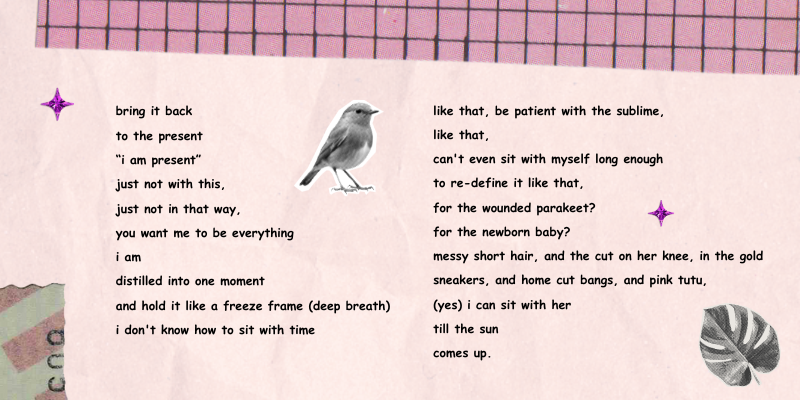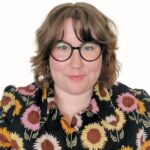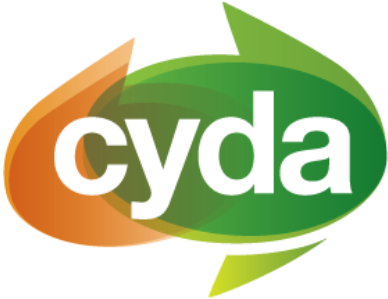Collective art projects like the zine have the power to create change. We spoke to 4 disabled artists about their inspirations and what storytelling means to them and their communities.
With 30 plus submissions from individual artists, the 2024 CYDA Summit Zine saw our largest collective creation of young people with disability ever. But what’s the power of shared story telling through a Zine? We talked to four of our amazing, featured artists about their inspirations, politics and personal experience in art, and the power of disabled storytelling.
Poppy (she/her), the author of the piece ‘A poem about my brain (and maybe your brain too)’, is a proud queer neurodivergent person who works as an Inclusion Consultant.
She tells us that the 64-line poem, found on pages 23-25 of the Zine, helps people step into the mind and experience of having ADHD by simulating the internal monologue of her lived experience. “To provide a reminder of how hard we try and how beautiful our minds are, even when it might seem to the outside world that we aren’t listening or don’t care,” she says.

Poppy has been drawn to poetry since she was 15 and says she loves the ability to capture a moment with so much depth and understanding. She says: “I feel poetry is also quite accessible as a neurodivergent person as it is short and sharp which helps me synthesise an idea or experience, deepening my own understanding of it.”
Like Poppy, Zoe (she/her) was able to bring her ideas to life and 3D immediately by using a laser cutter to create the sculptural pieces on page 19 of the zine.
For Zoe, her art fights inner negative self-talk and expectations others have of her. She says she’s heard too many times that “people like you don’t do business or technology”. But she defies these perceptions, making her creative social enterprise ‘The Bloom Cycle’ her own.

This defiance is what she wanted to convey in her pieces ‘Creativity takes courage’ and ‘Take up space’. Not only does her chosen art form achieve this but her statements reflect her feelings at Summit. “From growing up thinking I was a burden to everyone – the Summit made me feel validated, that there is space for everyone to share and that it’s okay to share your experiences”.
Beth (she/her), the digital illustrator who created the piece ‘It’s a support system not a marketing scheme’ took a different approach, addressing the systemic ways in which people with disability are made to feel like a burden.
She says that too often disabled people are thought of as costs only. Beth says that when the financials are the only thing focused on, we lose the bigger picture about what financial disadvantage actually means in real terms for people with disability.

“The general population needs to understand that we need more than just medical supports, we need whole of life supports” but she recognises how difficult this is when people are seen as “just a cost to deal with”. She hopes showing this sentiment in her piece, found on page 35, will allow people to take away what they are ready to and connect to the issue in a deeper way.
Siena (they/them), the artist behind the comics ‘Identity’ and ‘Creating Change’, agrees, telling us that comics are the perfect medium to “take a bite out of one big heavy idea and make it consumable for community and a wider audience”. They share that the power of comics is that as an artist and audience we are welcome to connect with ourselves and engage on the level we want to, especially for big topics.

Siena was inspired to create the comics when reflecting on the social model of disability and that so much of what is disabling is society and systems. The choice to use snails as the main characters in their comics was a deliberate one. They remark that snails are often perceived as slow and lazy, but for snails that’s their natural existence and not something they can change. This idea mirrors stereotypes often imposed on people with disability and relates to Siena’s lived experience with invisible disability.
All artists agree with the power of multimedia storytelling like the zine. “Poems, digital art, sculptures, it provides greater communication where words can’t do justice, it creates a fuller experience and allows you to process your experiences more deeply” says Beth.
Projects like the Zine offer a way of preserving the memory and culture of the disability community and highlighting disabled storytellers. They demonstrate that representation in art and media can be transformative to society. Poppy affirms: “I think disabled storytelling is essential to the connection and survival of our communities.”

About the author:
Rosie Putland (she/her) is a proudly Disabled Commications Officer at CYDA and is based in lutruwita/Tasmania. She is a social entrepreneur, on the board for the Regional Autistic Engagement Network (RAEN), and the founder of the Tasmanian Digital Accessibility Community. Rosie is known for her advocacy, storytelling, and her dedication to community.


